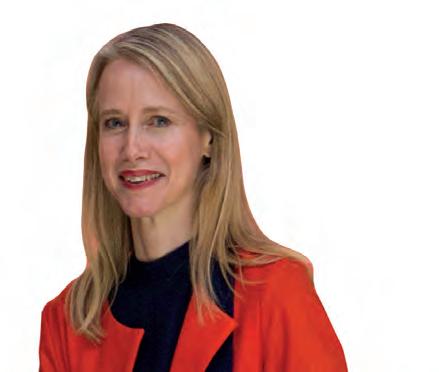
4 minute read
The Insider

front

MOUTHPIECE
The growth of digital and virtual reality experiences in galleries and museums is opening up a world of new galleries and museums is opening up a world of new opportunities, says Dovecot Studios director Celia Joicey opportunities, says Dovecot Studios director Celia Joicey
People are back inside museums and galleries. Successive lockdowns fast-tracked online access to our collections, curators engaged new audiences with social media and there were multiple opportunities to see and hear the history of art on Zoom. Yet, after two years of social distancing, there is pent-up demand for art in-person, especially when served with a slice of gallery café cake.
Some have seen this shift as a chance to continue innovating. The recently reopened Burrell Collection comes with a Bloomberg Philanthropies digital guide; the V&A Dundee has offered multi-sensory exhibitions including Michael Clark: Cosmic Dancer; and, at Dovecot, we scan every exhibition using Matterport to enable remote 3D access, plus our latest Raphael tapestry detail is being shown as part of a film and a digital exhibition (Raphael: Magister Raffaelo) tracing the artist’s life and work.
Meanwhile, curators worldwide are navigating how best to collect and present artworks with cutting-edge technological requirements, including 360-degree Virtual Reality headsets. There are also new digital art stars to contend with: this summer, Dovecot hosted an exclusive international party to celebrate artists creating Non-Fungible Tokens. Scotland might be home to more than one NFT artist, and our multivenue party highlighted the medium’s growth, but NFTs are a relatively new development.
It is early days for combining digital art and exhibitions and we are still learning. Perhaps the most exciting landscape for innovation can be found on a gaming console, with Scottish talent a major contributor. The booming games industry and clever VR environments highlight the opportunity to blend physical in-person museum experiences with augmented and VR environments. In future, it should be possible to personalise the visitor journey with multiple and intuitive access to digital assets on different platforms, including gaming. But, in practice, the technology remains expensive and can be unreliable.
It is hard to predict how post-pandemic museum visitors (and museum budgets) might evolve. But the commercial sector has faith. Currently, in Glasgow, you can travel instantaneously into the Sistine Chapel in Rome via the Old Ice Rink at Braehead Shopping Centre, part of a world exhibition tour; and, in recent months, the Van Gogh Alive experience in Edinburgh used film and projection to position visitors inside his paintings. These ventures are popular, profitable and Instragrammable, and their purely digital model means they can be replicated worldwide.
As yet, the world awaits a truly hybrid in-person and virtual exhibition experience that captures the full gamut of the human senses. At Dovecot, inspiration might just lie in tapestry. The 14th-century ‘The Lady And The Unicorn’ tapestries in Musee de Cluny, Paris, are a masterpiece in the history of art. Together, they immerse the viewer in a forest with a narrative that explores touch, taste, sight, sound, smell and a mysterious ‘sixth sense’ described as ‘à mon seul désir’ (to my only desire). Post-covid, the future for museum and gallery exhibitions lies not only in the art and exhibitions we curate, but in capturing imagination and desire. dovecotstudios.com
In this series of articles, we turn the focus back on ourselves by asking folk at The List about cultural artefacts that touch their heart and soul. This time around, Rachel Cronin tells us about cultural things which . . .
Made me cry: Phoebe Bridgers’ Manchester gig in July. Seeing my most favourite ‘sad girl’ in the flesh was a life achievement (and worth suffering the overnight Megabus). ‘Scott Street’ is my go-to crying song.
Made me angry: Happening by Audrey Diwan (last year’s film adaptation of Annie Ernaux’s L’événement). It hit me that this harrowing story of an illegal abortion in 1960s France is becoming more painfully relevant by the day.
Made me sad: Daniel Kwan and Daniel Scheinert’s Everything Everywhere All At Once. I caught it in the cinema last month and haven’t been the same since. So sad and poignant while also managing to be the most ridiculous film I’ve ever seen.
Made me think: Ruth Ewan’s The Beast. After hiking up Calton Hill to Collective, Ewan’s exhibition about the human consequences of capitalism had me feeling deflated.
Made me think twice: Women In The Picture by Catherine McCormack. Her book uncovers some uncomfortable revelations about depictions of women in art throughout history. She ruthlessly picks apart everything, from representations of Venus to problems behind glorifying the ‘sad girl’ phenomenon (I was devasted, but she’s so right).
THE INSIDER











